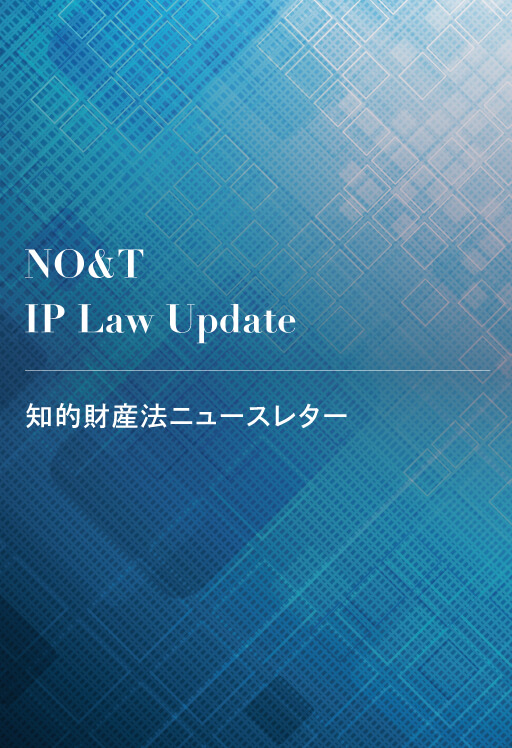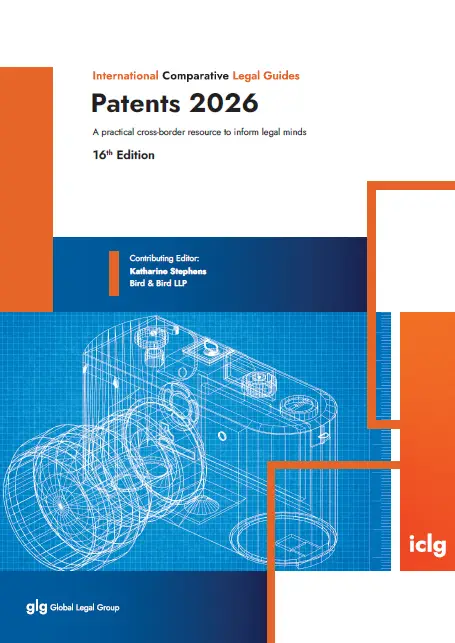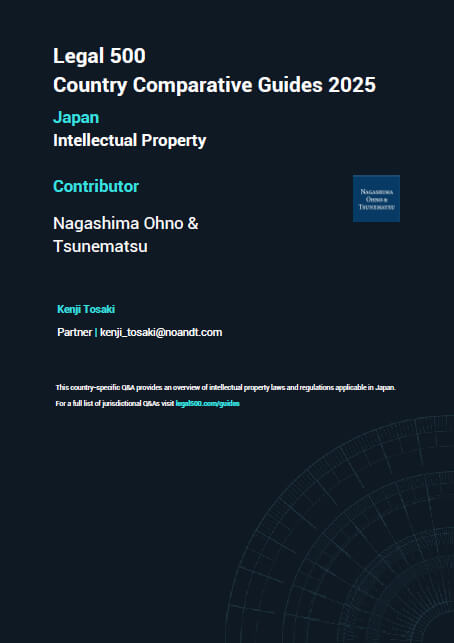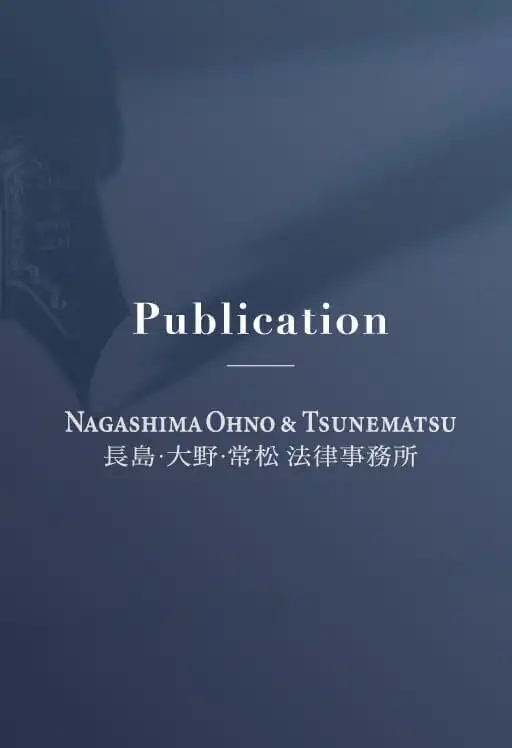
NO&T IP Law Update
As reported in NO&T IP Law Update No.8, on October 28, 2024, the Tokyo District Court issued a decision in a case involving a biosimilar manufacturer seeking a preliminary injunction against a patent holder (Samsung Bioepis Co. Ltd. v. Bayer HealthCare LLC. (Case Number: 2024 (Yo) 30029), hereinafter referred to as the “Bayer Case”). This decision is notable in that it addressed, for the first time, whether a statement concerning a potential infringement made by a patent holder to the Ministry of Health, Labour and Welfare (the “MHLW”), under the patent linkage system※1 may constitute “unfair competition” as defined in the Unfair Competition Prevention Act (the “UCPA”).
Following the Bayer Case decision, this same issue was addressed in another Tokyo District Court decision, issued on December 16, 2024, in a preliminary injunction case brought by the same biosimilar manufacturer (i.e., Samsung Bioepis Co., Ltd.; hereinafter referred to as the “Claimant”) against a pharmaceutical product patent holder (i.e., Regeneron Pharmaceuticals, Inc.; hereinafter referred to as “Regeneron”) (Case Number: 2024 (Yo) 30028, hereinafter referred to as the “Regeneron Case”). What is noteworthy about the Regeneron Case decision is that the court dismissed the preliminary injunction application upon consideration of different criteria from those considered in the Bayer Case.
In this newsletter, we provide an overview of the Tokyo District Court’s ruling in the Regeneron Case and provide our summary commentary in relation to this decision.
Initially, we note certain similarities in the factual backgrounds of the two cases. The same brand-name drug and the same biosimilar are at issue in both the Bayer Case and the Regeneron Case. The brand-name drug was “EYLEA® solution for IVT inj. 40mg/mL” (hereinafter referred to as the “Respondent’s Product”) which Bayer Yakuhin, Ltd. (“Bayer Yakuhin”) commenced selling in November 2012, as its marketing authorization holder. Also, Bayer Yakuhin is an affiliate of Bayer HealthCare LLC. (“Bayer”), the respondent in the Bayer Case.
Regeneron owns Patent No. 6855480, titled “Methods of associating genetic variants with a clinical outcome in patients suffering from age-related macular degeneration treated with anti-VEGF” (hereinafter referred to as the “’480 Patent”), which was registered with the Japan Patent Office on March 19, 2021, and Patent No. 7233754 under the same title as the ’480 Patent※2 (hereinafter referred to as the “’754 Patent”; and collectively with the ’480 Patent, the “Patents”), which was registered with the Japan Patent Office on February 27, 2023. Claim 1 of the ’480 Patent covers a use of a VEGF inhibitor in the manufacture of a pharmaceutical composition for the treatment of a certain group of age-related macular degeneration (“AMD”) patients, and Claim 1 of the ’754 Patent covers a use of aflibercept in the manufacture of a pharmaceutical composition for the treatment of another group of AMD patients.
On May 31, 2023, Global Regulatory Partners GK (hereinafter referred to as the “GRP”) filed a marketing authorization application for a biosimilar correspondent to the Respondent’s Product (hereinafter referred to as the “Claimant’s Product”). The Claimant’s Product was to be produced by Claimant. On the draft package insert for the Claimant’s Product which was submitted by GRP, the wording “age-related macular degeneration with choroidal neovascularization in the subfoveal area” (“wAMD”) was included in the “indications and usage” of the Claimant’s Product at the initial stage.
While GRP excluded the wAMD wording from the “indications and usage” of the package insert for the Claimant’s Product based on comments it received from the MHLW on November 9, 2023, prior to that, there had been a meeting regarding GRP’s application, involving the Claimant, GRP and the MHLW※3.
On the other hand, Bayer Yakuhin submitted the drug patent information report sheets※4 regarding the Patents and their supplementary explanations to the Pharmaceuticals and Medical Devices Agency※5 (PMDA) in accordance with Regeneron’s instruction. In the supplementary explanations, the following was stated: (i) there is a concern that the ’480 Patent will be infringed if the EYLEA BS is approved for use with wAMD, and with regard to the ’754 Patent, (ii) if a biosimilar correspondent to EYLEA is granted for the indications and usage for wAMD, there is an extremely high likelihood that it will be used for the patented use, and it is clear that it will infringe the ’754 Patent※6. In addition, in response to the MHLW’s inquiries, Regeneron conveyed to the MHLW, through Bayer Yakuhin, that (iii) the sale of a generic drug correspondent to EYLEA with the same indications and usage as EYLEA would constitute an infringement of the Patents (The communication of statements (i) through (iii) by Regeneron, via Bayer Yakuhin, to the MHLW and the PMDA are referred to as the “Statements.”).
The Claimant filed an application for a preliminary injunction with the Tokyo District Court, seeking to enjoin Regeneron from notifying the MHLW and the PMDA that the Claimant’s Product infringes the Patents. The Claimant argued that the Statements constitute acts of unfair competition under the UCPA, specifically an act of making or disseminating false statements that harm the business credibility of a business competitor (Article 2(1)(xxi) of the UCPA)※7, and that the Claimant’s business interests have been harmed by such acts of unfair competition.
The Tokyo District Court rendered its decision dismissing the Claimant’s application for preliminary injunction on December 16, 2024, based on the following criteria and findings.
The Tokyo District Court adjudicating the Regeneron Case (hereinafter referred to as the “Court”) acknowledged that the patent linkage system enables the MHLW to identify the potential infringement of a patent covering a brand-name drug by a correspondent generic drug based on information in a “drug patent information report sheet” submitted by the patent holder on the premise that such information is not to be made public. The court noted identifying potential patent infringements serves the purpose of ensuring a stable supply of pharmaceuticals by, among other things, avoiding recalls of infringing generic products as a result of patent infringement lawsuits, which impact the medical profession and patients.
The court further mentioned that considering this system is required for the MHLW to hear a wide range of opinions in order to appropriately exercise its authority to issue marketing authorization, patentees are expected to state their opinion regarding whether the manufacture and sale of a generic drug infringes the patents owned by them in the “drug patent information report sheet” (which is not to be made public) or in response to an inquiry from the MHLW.
With regard to the possibility that the patentee’s assertions are untrue (e.g., mentioning that the manufacture and sale of a generic drug will constitute an infringement of the patentee’s patent when in actuality they will not), the Court acknowledged that, given the purpose of the patent linkage system, it is necessary to ensure that patentees have an opportunity to state various opinions to a certain extent, including their views as to whether the manufacture and sale of a generic drug will constitute an infringement of their patent rights, regardless of whether such opinion has been confirmed by a judicial determination.
However, on the other hand, if the applicability of Article 2(1)(xxi) of the UCPA were to be denied merely because the statement is made under the patent linkage system, even in cases where the patentees have made a statement that harms the credibility of a generic drug manufacturer with an aim to gain an advantage in the market, or where the content or manner of the information provided is inappropriate (e.g., lacking accuracy or being overly exaggerated), it would be against the purpose of the UCPA, i.e., to ensure fair competition among businesses, thereby contributing to the sound development of the national economy.
Based on such acknowledgement, the Court concluded that even if a patent holder’s statements could be technically considered to be “false statements that harm the business credibility of a business competitor” as set forth in Article 2(1)(xxi) of the UCPA, the act of making such statements is a legitimate act that is expected under the patent linkage system and should not be considered as unlawful when the act is considered reasonable in light of the purpose of providing information on a drug patents under the patent linkage system.
In addition, when making the above determination of reasonableness, the following factors should be taken into account:
In analyzing the Regeneron Case, the Court pointed out the following factors:
Ultimately, the Court concluded that the Statements are regarded as legitimate acts (i.e., they do not constitute acts of unfair competition) without making a determination on the issue of whether the Claimant’s Products would actually infringe the Patents.
In the Regeneron Case decision, different criteria and considerations were applied when compared to the Bayer Case, in that while the Bayer Case focused on the appropriateness of the content of the allegedly false statements, the Regeneron Case focused instead on the appropriateness of the process of the provision of information.
Considering that there are just two district court decisions addressing the issue of whether a statement made by the patent holder to the MHLW regarding potential infringement, during the patent linkage process, may constitute an act of “unfair competition” as defined in the UCPA, and that each court analyzed the issue from a different perspective, at this point there is no clear guidance as to which criteria will be used in considering this issue in the future or whether other criteria (i.e., criteria other than those considered in the Bayer Case and the Regeneron Case) will be considered.
*1
For information regarding the patent linkage system in Japan, please refer to our NO&T IP Law Update No.8, “Recent Court Decision on (i) Scope of Medicinal Use Invention and (ii) Patent Linkage” (February, 2025).
*2
The ’754 Patent is granted for a divisional application of the application for the ’480 Patent.
*3
The court’s acknowledgement about this fact is redacted in the published version of the decision of the Regeneron Case, whereas such was not the case in the Bayer Case. Therefore, we have supplemented the factual background of the Regeneron Case based on information provided in the Bayer Case decision.
*4
Brand-name drug manufacturers or patentees can provide the MHLW with information by including such in a drug patent information report sheet under the Japanese patent linkage system.
*5
The PMDA is the agency that conducts scientific reviews of marketing authorization applications.
*6
In the published judgement, the exact wording is unclear because some portions of the supplementary explanations are redacted. Consequently, we included supplemental information in this sentence.
*7
In practice, if a statement is made to a third party claiming that a competitor infringes a patent, and a court later rules that the patent is not infringed, such a statement is considered a “false statement.” The third party to whom the statement is made is typically a customer of the competitor, but in recent years, there have been cases where claims of infringement of intellectual property rights made against an operator of a digital platform, such as an e-commerce site or SNS, have been disputed as a false statement.
This newsletter is given as general information for reference purposes only and therefore does not constitute our firm’s legal advice. Any opinion stated in this newsletter is a personal view of the author(s) and not our firm’s official view. For any specific matter or legal issue, please do not rely on this newsletter but make sure to consult a legal adviser. We would be delighted to answer your questions, if any.


(October 2025)
Kenji Tosaki


Kenji Tosaki, Takahiro Hatori, Nozomi Kato (Co-author)


(September 2025)
Kenji Tosaki


Kenji Tosaki, Ryo Tonomura (Co-author)


(October 2025)
Kenji Tosaki


Kenji Tosaki, Takahiro Hatori, Nozomi Kato (Co-author)


Claire Chong, Nozomi Kato (Co-author)


(September 2025)
Kenji Tosaki


(October 2025)
Kenji Tosaki


Kenji Tosaki, Takahiro Hatori, Nozomi Kato (Co-author)


(September 2025)
Kenji Tosaki


Kenji Tosaki, Ryo Tonomura (Co-author)


Kenji Tosaki, Takahiro Hatori, Nozomi Kato (Co-author)


Kenji Tosaki, Ryo Tonomura (Co-author)


Kenji Tosaki, Takahito Hirayama (Co-author)


Kenji Tosaki, Nozomi Kato (Co-author)


Kenji Tosaki, Takahiro Hatori, Nozomi Kato (Co-author)


Kenji Tosaki, Ryo Tonomura (Co-author)


(June 2025)
Shin Koike


Kenji Tosaki, Takahito Hirayama (Co-author)